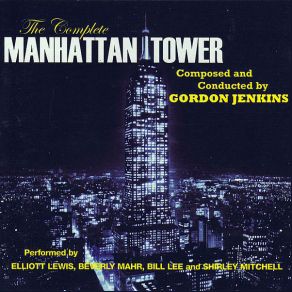The Complete Manhattan Tower
Download links and information about The Complete Manhattan Tower by Gordon Jenkins. This album was released in 1956 and it belongs to Jazz, Rock, Pop, Theatre/Soundtrack genres. It contains 24 tracks with total duration of 01:16:00 minutes.

|
|
|---|---|
| Artist: | Gordon Jenkins |
| Release date: | 1956 |
| Genre: | Jazz, Rock, Pop, Theatre/Soundtrack |
| Tracks: | 24 |
| Duration: | 01:16:00 |
| Buy it NOW at: | |
| Buy on iTunes $9.99 | |
| Buy on Amazon $8.99 | |
Tracks
[Edit]| No. | Title | Length |
|---|---|---|
| 1. | Magical City | 5:20 |
| 2. | Manhattan Tower / Happiness Cocktail | 4:12 |
| 3. | I'm Learnin' My Latin | 3:05 |
| 4. | Once Upon a Dream | 3:17 |
| 5. | Never Leave Me | 3:51 |
| 6. | This Close to the Dawn | 3:13 |
| 7. | Repeat After Me | 1:49 |
| 8. | Repeat After Me (Reprise) | 3:39 |
| 9. | The Magic Fire | 2:35 |
| 10. | Married I Can Always Get | 5:13 |
| 11. | The Statue of Liberty | 2:22 |
| 12. | The Party | 2:47 |
| 13. | New York's My Home | 4:29 |
| 14. | Closing | 1:59 |
| 15. | Theme (From "Seven Dreams") [Bonus Track] | 3:06 |
| 16. | My Own (Bonus Track) | 2:31 |
| 17. | Tired of Waitin' (Bonus Track) | 2:46 |
| 18. | Young Ideas (Bonus Track) | 2:45 |
| 19. | Angel's Lullaby (Bonus Track) | 2:45 |
| 20. | Through the Night (Bonus Track) | 2:36 |
| 21. | Follow Me, Baby (Bonus Track) | 2:41 |
| 22. | Wish I Could Say the Same (Bonus Track) | 2:49 |
| 23. | How Do I Love You? (Bonus Track) | 3:02 |
| 24. | You're Not Alone (Bonus Track) | 3:08 |
Details
[Edit]Gordon Jenkins' Manhattan Tower is a musical milestone in several respects. It is a unique blend of elements, part pop orchestral, almost classical suite, and part radio-styled narrative, part musical, and part operetta. It began life in 1946 as a four-part suite on a 78 rpm set of Decca Records, featuring a small cast headed by actor Elliott Lewis. This modestly ambitious set took hold in the hearts of New Yorkers and earned Jenkins the Key to the City in 1950, presented to him after a semi-staged version of Manhattan Tower appeared on Talk of the Town, an early version of Ed Sullivan's televised weekly variety show. Manhattan Tower, with its implication of romance and its lush and tasteful evocation of a kind of idealized city life in New York, won Jenkins many friends, and its unusual dramatic and musical format may have influenced the rise of Industrial musicals, beginning in the early '50s. In 1956, executives at Capitol Records, who were building their own pancake stack-styled tower at the corner of Hollywood and Vine, invited Jenkins to expand on his original concept, and the result forms the heart of Sepia Records' The Complete Manhattan Tower. This time the romantic element in the story moved from implicit to explicit, with actress Beverly Mahr (Jenkins' own wife) added as a love interest, Julie, to Elliott Lewis' Steven. With the project moving from the 78 album format into the LP arena, Jenkins was able to more than double its content, though it is more "different from" than "better" in regard to the 1946 version. People who the couple encounters on their dates and travels together briefly step into the story and comment on their own dreams and desires. The Sepia CD is filled out with some miscellaneous tracks of Jenkins' productions from the '50s, odd tunes from singles recorded for RCA Victor's short-lived X imprint. Among the best of them are two delicious Jenkins piano solos, a superb Tabby Calvin vocal on "Tired of Waitin'," and a fun, wiseacre number called "Follow Me Baby" featuring a vocal by the Pitch Pipes. Not much of this material, and to some degree not even Manhattan Tower, wears very well — it is by turns lush, sentimental, street smart and aggressively commercial, and stylistically it belongs to its time. But it's highly intelligent and well crafted '50s camp, and holds up a great deal better than say, Sunny Skylar's The Hidden Island with actor David Janssen recorded about a decade later, which is by turns hilariously awful and stomach churning by comparison. The Complete Manhattan Tower may be made out of cheese, but it's highly tasty cheese, and it's not hard at all to imagine listeners who enjoy a little easy listening, and a light-hearted, romantic story, to develop a taste for it. Fans of musical comedy will love the party scene in Manhattan Tower — it's one of many small things that make this work so original and unusual. The sound of the Sepia Records issue, taken from original master tapes, is excellent. [EMI/DRG released a condensed version of the album subtitled Highlights, Rovi